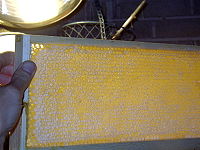
Frame (beehive)
Encyclopedia

Beehive (beekeeping)
A beehive is an enclosed structure in which some honey bee species of the subgenus Apis live and raise their young. Natural beehives are naturally occurring structures occupied by honeybee colonies, while domesticated honeybees live in man-made beehives, often in an apiary. These man-made...
is the structural element that holds the honeycomb
Honeycomb
A honeycomb is a mass of hexagonal waxcells built by honey bees in their nests to contain their larvae and stores of honey and pollen.Beekeepers may remove the entire honeycomb to harvest honey...
or brood comb
Brood comb
The brood comb is the beeswax structure of cells where the queen bee lays eggs. It is the part of the beehive where a new brood is raised by the colony...
within the hive body (or "super"). The frame is a key part of the modern "movable" hive since it can be removed in order to inspect the bees for disease or to extract the excess honey.
History
One of first beehive frames was devised by Petro ProkopovychPetro Prokopovych
Petro Prokopovych was the founder of commercial beekeeping. He introduced a number of novelties in traditional beekeeping that allowed significant progress in the practice. Among his most important inventions was a frame in separate honey chamber of his beehive...
in 1814
. However the distance between frames was too big and the frame lay on supporting strips of wood. As a result, the frames were cross-attached by burr comb and propolized to the supporting strips and were difficult to remove. In Prokopovych's design, the frames were placed only in the honey chamber. In the brood chamber, the bees built the combs in free style.
Jan Dzierzon
Jan Dzierzon
Johann Dzierzon, in Polish Jan Dzierżon or Dzierżoń , also John Dzierzon , was a pioneering apiarist who discovered the phenomenon of parthenogenesis in bees and designed the first successful movable-frame beehive.Dzierzon came from a Polish family in Silesia...
described the correct distance between combs in the brood chamber as 1½ inches from the center of one bar to the center of the next. In 1848, Dzierzon introduced grooves into the hive’s side walls replacing the strips of wood to hang top bars. The grooves were 8 mm apart and met the distance requirements for a bee space.
August von Berlepsch (May 1852) in Thuringia
Thuringia
The Free State of Thuringia is a state of Germany, located in the central part of the country.It has an area of and 2.29 million inhabitants, making it the sixth smallest by area and the fifth smallest by population of Germany's sixteen states....
and
L. L. Langstroth
L. L. Langstroth
Rev. Lorenzo Lorraine Langstroth , apiarist, clergyman and teacher, is considered the "Father of American Beekeeping."L. L. Langstroth was born in Philadelphia, Pennsylvania...
(October 1852) in the United States also designed movable frame hives. Today, the Langstroth hive
Langstroth hive
The Langstroth bee hive, patented in October 1852, is the standard beehive used in many parts of the world for beekeeping. The advantage of this hive is that the bees build honeycomb into frames, which can be moved with ease. The frames are designed to prevent bees from attaching honeycombs where...
is the most common design.
Standard Size
A Langstroth hive is designed to hold ten frames spaced 1½ inches (38 mm) center to center (but may have as few as 8 frames if the comb can be drawn out more widely within the frame to maintain the beespace). The top bar length is 19 inches (48.3 cm). The depth of the frame varies. Frames are made from wood or plastic.Specialty frames such as cell bar frames are used to raise new queens
Queen bee
The term queen bee is typically used to refer to an adult, mated female that lives in a honey bee colony or hive; she is usually the mother of most, if not all, the bees in the hive. The queens are developed from larvae selected by worker bees and specially fed in order to become sexually mature...
.

